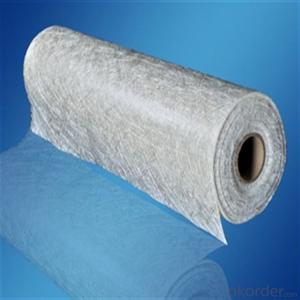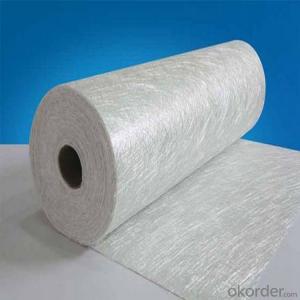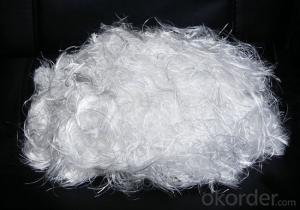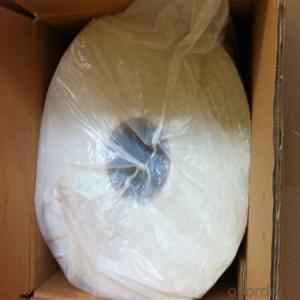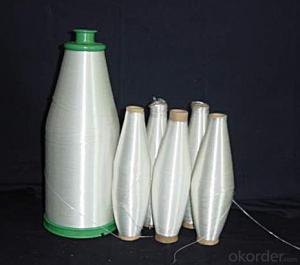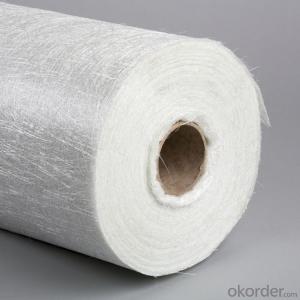Fiberglass Emulsion Chop Strand Mat/Fiberglass CSM/Fiberglass Mat
- Loading Port:
- China main port
- Payment Terms:
- TT OR LC
- Min Order Qty:
- 1 kg
- Supply Capability:
- 10000 kg/month
OKorder Service Pledge
OKorder Financial Service
You Might Also Like
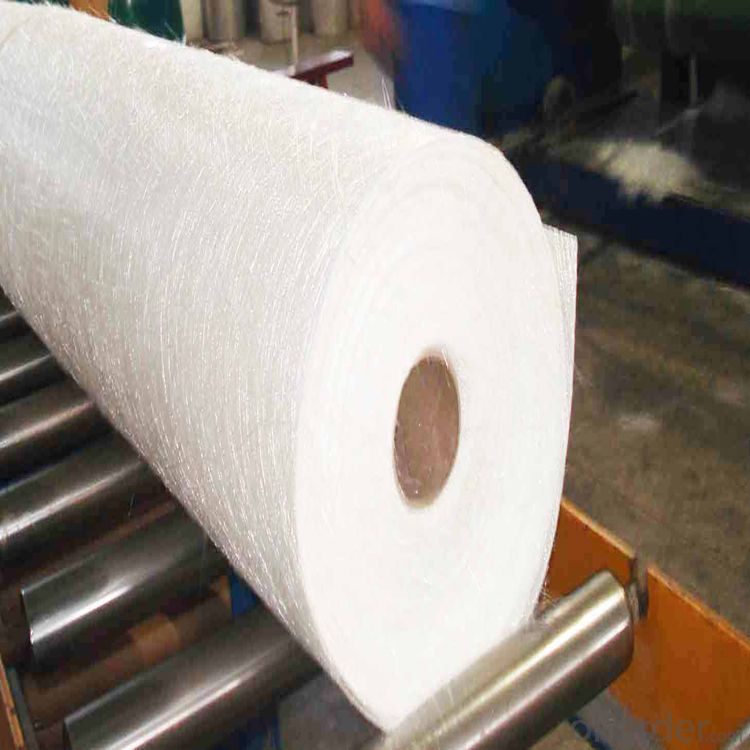
Product Description:
Fiberglass Chopped Strand Mat is fine strand reinforcement material made from E-glass cut fibers laid in a random pattern and bonded with powder or emulsion binder.
It is easy to handle and has excellent moulding performance.
Also, it has rapid resin penetration together with a fast strand wet out time.
The mat also brings a highly translucent finished laminates.
Also,the fine strand input makes the fiber prominence at the finished laminates surface extremely low.
Features
1.Excellent weight uniformity
2.Fast wet out
3.Easy air release
4.Excellent transparency of finished products
5.Excellent laminate
6.Low resin consumption
Application
1.Translucent roof panel
2.chemical storage tanks
3.FRP pipes
4.Boat hulls
5.Decks
6.Truck body panel
7.Cooling towers
8.Corrosion resistand
Specifications:
Item | Over Density | Moisture Content | Chop Density | Polyester Yarn | Width |
(g/m2) | (%) | (g/m2) | (g/m2) | (mm) | |
EMK300 | 309.5 | ≤0.15 | 300 | 9.5 | 50-3300 |
EMK380 | 399 | 380 | 19 | ||
EMK450 | 459.5 | 450 | 9.5 | ||
EMK450 | 469 | 450 | 19 | ||
EMC0020 | 620.9 | 601.9 | 19 | ||
EMC0030 | 909.5 | 900 | 9.5 |
Special products are available according to customer’s requirement.
Product Packaging:
Each Surface Tissue is wound onto a paper tube which has an inside diameter of 76mm and the mat roll has a diameter of 330mm. The mat roll is wrapped up with plastic film,and then packed in a cardboard box or wrapped up with kraft paper. The rolls can be vertically or horizontally placed. For transportation, the rolls can be loaded into a cantainer directly or on pallets.
Quantity
20'GP Container:About 10000kgs
40'HP Container:Aboout 23100kgs
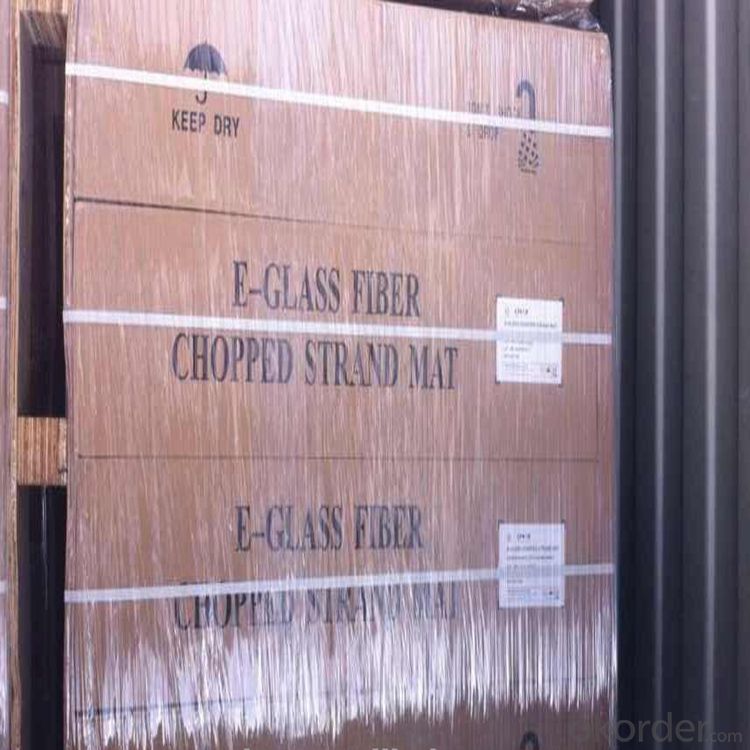
Product Storage:
Unless otherwise specified, Chopped Strand Mat should be stored in a dry, cool and rain-proof area. It is recommended that the room temperature and humidity should be always maintained at 15℃~35℃ and 50%~75% respectively.
Company Information
CNBM (China National Building Material) Group is the largest comprehensive building materials group in China that in integrate scientific research, manufacturing and logistics into one entity. The largest building materials and equipment specialists in China. Upon State Council approval, today CNBM owned more than 300 subordinate manufacturing factories and servicing companies. There are 6 fully owned public listed companies and 11 partially owned with substantial shares public listed companies. In many of these fields, CNBM is playing the leading role in the building industry in the country.

Our Service:
1.Any inquiry will be replied within 24 hours.
2.Professional manufacturer.
1) Print logo in the products;
2) The size and specification can be produce and design according to your demand.
3.High quality,fashion designs,reasonable and competitive price,fast lead time.
4.After-sale service
1) All products will have been strictly quality check in house before packing.
2) All products will be well packed before shipping.
3) All our products have 10 years rot resistance.
5.Faster delivery:sample order in stock,and 15-20 days for bulk production.
6.Payment:you can pay for the order via:T/T,Western Union,MoneyGram,L/C etc.
FAQ:
which kind of glass fiber sample and materials can you provide?
We can provide the glass fiber and glass fiber down stream products samples of E glass, C glass, ECR glass, High alkali glass. The products includes single end roving, assembled roving for different applications( Piping, SMC, panel, winding mill plate) , chop strand for BMC, engineering plastic (PA, PPA, PPT, POM, etc), chop strand mat (from 100gsm-900gsm) for automobile and water tank, etc, woven roving (270gsm-800gsm), surface tissue (25-50gsm), multi-axial fabric of different unit weight.
- Q:Is fiberglass chopped strand suitable for electrical grounding applications?
- No, fiberglass chopped strand is not suitable for electrical grounding applications.
- Q:How does the fiber orientation of fiberglass chopped strand affect the mechanical properties of composites?
- The mechanical properties of composites are greatly influenced by the fiber orientation of fiberglass chopped strand. Fiberglass chopped strand is made up of short individual fibers that are randomly oriented in various directions. When these chopped strands are added to a composite material, the fiber orientation becomes a crucial factor in determining the overall strength, stiffness, and other mechanical properties of the resulting composite. In general, a well-aligned fiber orientation within the composite can result in improved mechanical properties. When the fibers are aligned in the same direction as the applied load or stress, they can effectively transfer the load and resist deformation, thereby increasing the strength and stiffness of the composite. This alignment also enhances the load-bearing capacity of the composite material. Conversely, a random or less aligned fiber orientation can lead to decreased mechanical properties. Randomly oriented fibers may not distribute the applied load effectively, causing stress concentrations and potential failure points within the composite. This can result in reduced strength, stiffness, and overall performance. Additionally, the fiber orientation can also impact other mechanical properties such as impact resistance, fatigue resistance, and dimensional stability. Proper fiber alignment can enhance these properties, making the composite material more resistant to impacts, cyclic loading, and dimensional changes. In conclusion, the fiber orientation of fiberglass chopped strand has a significant impact on the mechanical properties of composites. A well-aligned fiber orientation can enhance strength, stiffness, impact resistance, fatigue resistance, and dimensional stability. Conversely, a random or less aligned fiber orientation can lead to reduced performance in these aspects. Therefore, careful consideration of fiber orientation is crucial in the design and manufacture of composites with desired mechanical properties.
- Q:How is the abrasion resistance of fiberglass chopped strand composites tested?
- The abrasion resistance of fiberglass chopped strand composites is typically tested using standardized methods such as ASTM D4060 or Taber Abrasion Test. These tests involve subjecting the composite material to abrasive wear by rubbing it against a specified abrasive material under controlled conditions. In the ASTM D4060 test, a rotating wheel with a specific abrasive material is pressed against the surface of the composite sample. The wheel applies a predetermined load and moves in a circular path, causing abrasion on the sample. The test is performed for a specified number of cycles or until a certain level of wear is achieved. The weight loss or change in appearance of the sample is then measured to determine its abrasion resistance. Similarly, the Taber Abrasion Test utilizes a specialized machine that applies a specific type and level of abrasion to the composite material. The sample is mounted on a rotating turntable, and abrasive wheels or disks are pressed against the sample surface while it rotates. The test is performed for a specified number of cycles, and the weight loss or change in appearance of the sample is measured to evaluate its abrasion resistance. Both methods provide quantitative data on the abrasion resistance of fiberglass chopped strand composites, allowing manufacturers and researchers to assess the material's durability and suitability for various applications. These tests help in designing and selecting materials that can withstand wear and provide long-lasting performance in environments where abrasion is a concern, such as automotive components, marine applications, or industrial equipment.
- Q:Can fiberglass chopped strand be used in aerospace interior components?
- Fiberglass chopped strand is indeed applicable for aerospace interior components. This lightweight and versatile material possesses exceptional strength and durability, making it widely utilized across various industries, including aerospace. The aerospace sector demands interior components that are both lightweight and capable of withstanding the rigorous conditions of flight. Fiberglass chopped strand fulfills these requirements, as it is lightweight and boasts high tensile strength. It finds extensive use in the production of panels, seat backs, overhead bins, and cabin partitions. Notably, fiberglass chopped strand exhibits exceptional fire resistance properties, which are of utmost importance in aerospace applications. It successfully adheres to the stringent fire safety regulations and standards set by aviation authorities. Moreover, the processing of fiberglass chopped strand is relatively straightforward, ensuring efficient and cost-effective manufacturing processes. It can be molded into diverse shapes and sizes, making it ideal for intricate aerospace interior designs. In summary, fiberglass chopped strand is an ideal material for aerospace interior components due to its lightweight nature, high strength, fire resistance, and ease of processing. Its utilization in the aerospace industry contributes to the safety, performance, and comfort of both passengers and crew members during flights.
- Q:How does the fiber content affect the thermal conductivity of chopped strand composites?
- The fiber content has a significant impact on the thermal conductivity of chopped strand composites. As the fiber content increases, the thermal conductivity of the composite generally decreases. This is because the fibers act as insulating barriers, impeding the flow of heat through the material. The thermal conductivity of a material is determined by its ability to conduct heat. In chopped strand composites, the fibers are dispersed throughout a matrix material, which can be a polymer or a resin. The presence of fibers creates a network of thermal resistances within the composite, which reduces the overall thermal conductivity. When the fiber content is low, the spacing between the fibers is larger, allowing for more heat transfer pathways between the matrix material. This leads to higher thermal conductivity. However, as the fiber content increases, the spacing between the fibers decreases, increasing the number of thermal resistances and decreasing the thermal conductivity. Additionally, the aspect ratio of the fibers also plays a role in determining the thermal conductivity of chopped strand composites. Longer fibers with a higher aspect ratio provide more resistance to heat transfer, further reducing the thermal conductivity. It is important to note that other factors, such as the properties of the matrix material, the alignment and orientation of the fibers, and the interfacial bonding between the fibers and the matrix, can also influence the thermal conductivity of chopped strand composites. Therefore, a comprehensive understanding of these factors is essential for accurately predicting and controlling the thermal conductivity of these materials.
- Q:How does the fiber-matrix interfacial shear strength of fiberglass chopped strand affect the performance of composites?
- The fiber-matrix interfacial shear strength of fiberglass chopped strand plays a crucial role in determining the performance of composites. This parameter refers to the strength of the bond between the fiberglass fibers and the matrix material in a composite. The interfacial shear strength directly affects the load transfer capability between the fibers and the matrix. A higher interfacial shear strength means a stronger bond between the fibers and the matrix, resulting in better load transfer and improved mechanical properties of the composite. When the interfacial shear strength is high, it allows for efficient stress transfer between the fibers and the matrix during loading, resulting in enhanced strength, stiffness, and overall performance of the composite material. This is particularly important in applications where the composite is subjected to high mechanical loads or structural stresses. On the other hand, a weak or low interfacial shear strength can lead to poor load transfer, resulting in reduced performance of the composite. In such cases, the fibers may not effectively reinforce the matrix, leading to premature failure, decreased strength, and lower overall mechanical properties. The interfacial shear strength also influences other properties of composites, such as fatigue resistance, impact resistance, and dimensional stability. A strong fiber-matrix bond improves the resistance of the composite to fatigue, preventing the initiation and propagation of cracks under cyclic loading. Additionally, a high interfacial shear strength helps to absorb and dissipate energy during impact events, enhancing the impact resistance of the composite. Moreover, the interfacial shear strength affects the dimensional stability of composites. A strong bond between the fibers and the matrix helps to minimize the occurrence of microcracks and debonding at the interface, reducing the potential for moisture absorption, creep, and dimensional changes over time. In summary, the fiber-matrix interfacial shear strength of fiberglass chopped strand significantly impacts the performance of composites. A strong bond between the fibers and the matrix enhances load transfer, improving mechanical properties, fatigue resistance, impact resistance, and dimensional stability. Therefore, optimizing and controlling the interfacial shear strength is crucial for designing and manufacturing high-performance fiberglass composite materials.
- Q:Can fiberglass chopped strand be used in the production of lightweight panels?
- Indeed, lightweight panels can be produced using fiberglass chopped strand. This particular reinforcement material comprises small strands of glass fibers. Typically, these fibers are cut into short lengths and then mixed with a resin matrix to generate a composite material. The utilization of fiberglass chopped strand in lightweight panel production offers numerous benefits. Firstly, fiberglass is renowned for its exceptional strength-to-weight ratio. Consequently, it provides outstanding structural integrity while minimizing the weight of the panels. This proves especially advantageous in industries like automotive and aerospace, where weight reduction is critical. Furthermore, fiberglass chopped strand can be easily molded into intricate shapes, enabling the creation of panels with elaborate designs. This flexibility in shaping also allows for the customization of panels to meet specific requirements, such as withstanding high temperatures or resisting corrosion. Additionally, fiberglass chopped strand is a cost-effective alternative when compared to other reinforcement materials. This affordability factor contributes to its popularity in lightweight panel production. The material is readily accessible, and its production process is relatively straightforward, ensuring efficient mass production. To conclude, fiberglass chopped strand is certainly suitable for the production of lightweight panels. Its high strength-to-weight ratio, shaping versatility, cost-effectiveness, and availability make it a viable option for various industries seeking durable yet lightweight panels.
- Q:How is the surface treatment of fiberglass chopped strand done?
- The surface treatment of fiberglass chopped strand is typically done through a process called sizing. Sizing involves applying a chemical coating to the strands to improve their adhesion to resins or other materials during manufacturing. This treatment helps enhance the overall strength and performance of fiberglass composites.
- Q:Is fiberglass chopped strand suitable for architectural applications?
- Architectural applications can benefit greatly from the use of fiberglass chopped strand. This versatile material offers numerous advantages and is well-suited for architectural purposes. It is lightweight, strong, durable, and resistant to corrosion, making it an excellent choice for a variety of architectural components. When it comes to architectural applications, fiberglass chopped strand has a wide range of uses. It can be used to reinforce architectural panels, walls, and ceilings, providing additional strength and stability. Furthermore, fiberglass can be molded into different shapes and forms, allowing architects to explore creative design possibilities. Architects can also utilize fiberglass chopped strand to create distinctive architectural features like columns, domes, and arches. Its malleability enables it to be easily shaped and formed into intricate designs, offering architects the flexibility to create visually appealing structures. Another advantage of fiberglass chopped strand is its resistance to fire and chemicals. This makes it suitable for architectural applications where fire and chemical resistance are crucial factors to consider, especially in industrial or commercial buildings. Moreover, fiberglass chopped strand is a cost-effective alternative to materials like steel or concrete. It requires less maintenance and has a longer lifespan, making it a cost-efficient choice for architectural projects. In conclusion, fiberglass chopped strand is an ideal material for architectural applications due to its lightweight nature, strength, durability, corrosion resistance, fire resistance, chemical resistance, and cost-effectiveness. Its versatility and ability to be molded into various shapes and forms make it an excellent choice for architectural components and features.
- Q:Can fiberglass chopped strand be used in the production of wind turbine components?
- Yes, fiberglass chopped strand can be used in the production of wind turbine components. It is commonly used as a reinforcement material in composite manufacturing processes to enhance the strength and durability of various wind turbine parts, such as blades and nacelles.
1. Manufacturer Overview |
|
|---|---|
| Location | |
| Year Established | |
| Annual Output Value | |
| Main Markets | |
| Company Certifications | |
2. Manufacturer Certificates |
|
|---|---|
| a) Certification Name | |
| Range | |
| Reference | |
| Validity Period | |
3. Manufacturer Capability |
|
|---|---|
| a)Trade Capacity | |
| Nearest Port | |
| Export Percentage | |
| No.of Employees in Trade Department | |
| Language Spoken: | |
| b)Factory Information | |
| Factory Size: | |
| No. of Production Lines | |
| Contract Manufacturing | |
| Product Price Range | |
Send your message to us
Fiberglass Emulsion Chop Strand Mat/Fiberglass CSM/Fiberglass Mat
- Loading Port:
- China main port
- Payment Terms:
- TT OR LC
- Min Order Qty:
- 1 kg
- Supply Capability:
- 10000 kg/month
OKorder Service Pledge
OKorder Financial Service
Similar products
New products
Hot products
Related keywords
